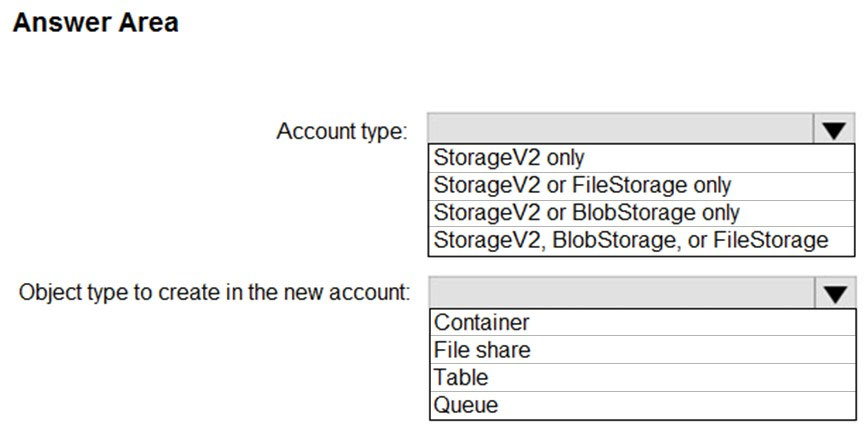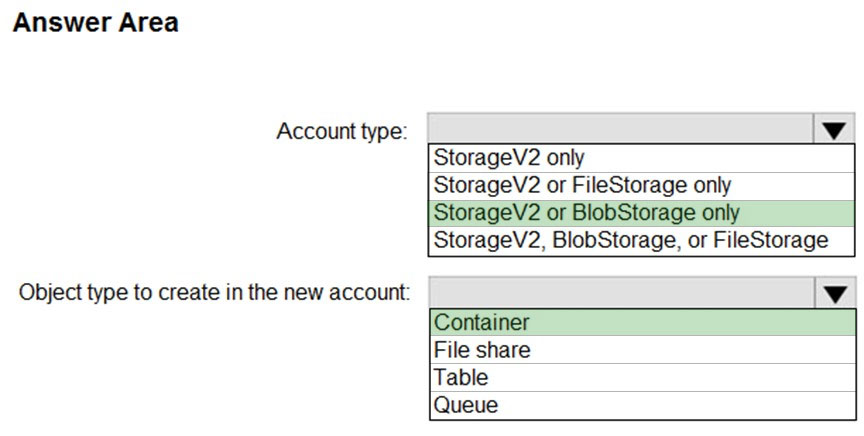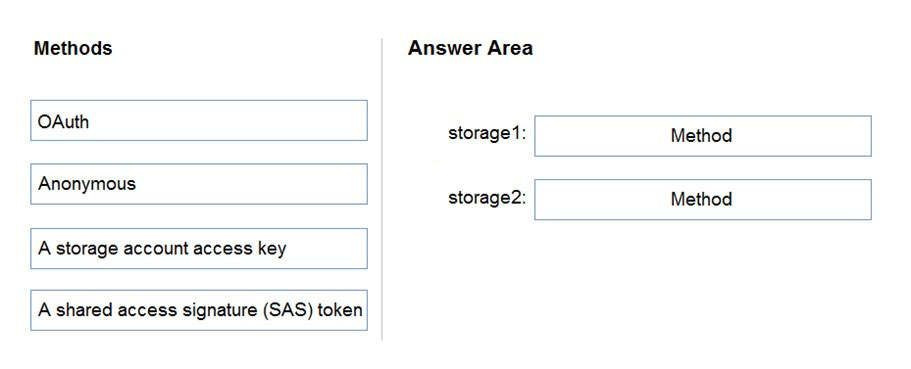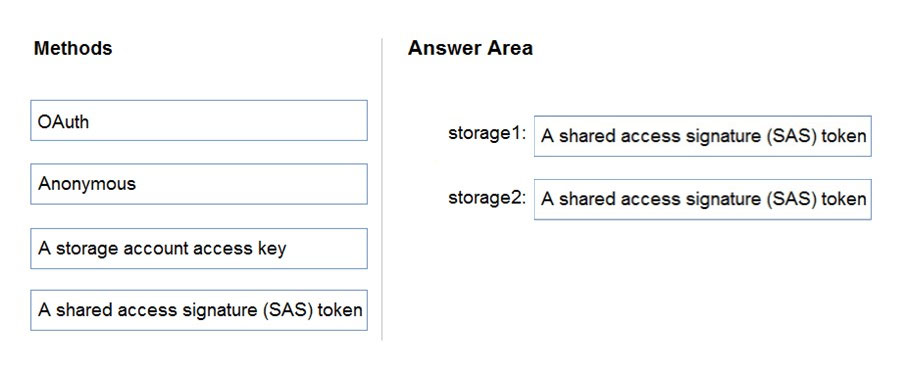HOTSPOT -
You have an Azure Storage account named storage1 that contains a blob container. The blob container has a default access tier of Hot. Storage1 contains a container named conainer1.
You create lifecycle management rules in storage1 as shown in the following table.
You perform the actions shown in the following table.
For each of the following statements, select Yes if the statement is true. Otherwise, select No.
NOTE: Each correct selection is worth one point.
Hot Area:
Answer:

You are configuring Azure Active Directory (Azure AD) authentication for an Azure Storage account named storage1.
You need to ensure that the members of a group named Group1 can upload files by using the Azure portal. The solution must use the principle of least privilege.
Which two roles should you configure for storage1? Each correct answer presents part of the solution.
NOTE: Each correct selection is worth one point.
Answer:
BC
To access blob data in the Azure portal with Azure AD credentials, a user must have the following role assignments:
* A data access role, such as Storage Blob Data Reader or Storage Blob Data Contributor
* The Azure Resource Manager Reader role, at a minimum
The Reader role is an Azure Resource Manager role that permits users to view storage account resources, but not modify them. It does not provide read permissions to data in Azure Storage, but only to account management resources. The Reader role is necessary so that users can navigate to blob containers in the Azure portal.
Note: in order from least to greatest permissions:
The Reader and Data Access role -
The Storage Account Contributor role
The Azure Resource Manager Contributor role
The Azure Resource Manager Owner role
Reference:
https://docs.microsoft.com/en-us/azure/storage/blobs/assign-azure-role-data-access
HOTSPOT -
You have an Azure Storage account named storage1 that stores images.
You need to create a new storage account and replicate the images in storage1 to the new account by using object replication.
How should you configure the new account? To answer, select the appropriate options in the answer area.
NOTE: Each correct selection is worth one point.
Hot Area:
Answer:

Reference:
https://docs.microsoft.com/en-us/azure/storage/blobs/object-replication-overview
You have an on-premises server that contains a folder named D:\Folder1.
You need to copy the contents of D:\Folder1 to the public container in an Azure Storage account named contosodata.
Which command should you run?
Answer:
C
The azcopy copy command copies a directory (and all of the files in that directory) to a blob container. The result is a directory in the container by the same name.
Incorrect Answers:
B: The azcopy sync command replicates the source location to the destination location. However, the file is skipped if the last modified time in the destination is more recent.
D: The az storage blob copy start-batch command copies multiple blobs to a blob container.
Reference:
https://docs.microsoft.com/en-us/azure/storage/common/storage-use-azcopy-blobs https://docs.microsoft.com/en-us/azure/storage/common/storage-ref-azcopy-copy
You have an Azure subscription.
In the Azure portal, you plan to create a storage account named storage1 that will have the following settings:
✑ Performance: Standard
✑ Replication: Zone-redundant storage (ZRS)
✑ Access tier (default): Cool
✑ Hierarchical namespace: Disabled
You need to ensure that you can set Account kind for storage1 to BlockBlobStorage.
Which setting should you modify first?
Answer:
A
Reference:
https://docs.microsoft.com/en-us/azure/storage/common/storage-account-overview https://docs.microsoft.com/en-us/azure/storage/blobs/storage-blob-performance-tiers
DRAG DROP -
You have an Azure subscription that contains the storage accounts shown in the following table.
You plan to use AzCopy to copy a blob from container1 directly to share1.
You need to identify which authentication method to use when you use AzCopy.
What should you identify for each account? To answer, drag the appropriate authentication methods to the correct accounts. Each method may be used once, more than once, or not at all. You may need to drag the split bar between panes or scroll to view content.
NOTE: Each correct selection is worth one point.
Select and Place:
Answer:

Box 1: A shared access signature (SAS) token.
You can provide authorization credentials by using Azure Active Directory (AD), or by using a Shared Access Signature (SAS) token.
For Blob storage you can use Azure AD & SAS.
Note: In the current release, if you plan to copy blobs between storage accounts, you'll have to append a SAS token to each source URL. You can omit the SAS token only from the destination URL.
Box 2: A shared access signature (SAS) token.
For File storage you can only use SAS.
Reference:
https://docs.microsoft.com/en-us/azure/storage/common/storage-use-azcopy-v10
You create an Azure Storage account.
You plan to add 10 blob containers to the storage account.
For one of the containers, you need to use a different key to encrypt data at rest.
What should you do before you create the container?
Answer:
D
Encryption scopes enable you to manage encryption with a key that is scoped to a container or an individual blob. You can use encryption scopes to create secure boundaries between data that resides in the same storage account but belongs to different customers.
Reference:
https://docs.microsoft.com/en-us/azure/storage/blobs/encryption-scope-overview
HOTSPOT
-
You have an Azure subscription. The subscription contains a storage account named storage1 that has the lifecycle management rules shown in the following table.
On June 1, you store two blobs in storage1 as shown in the following table.
For each of the following statements, select Yes if the statement is true. Otherwise, select No.
NOTE: Each correct selection is worth one point.
Answer:

HOTSPOT
-
You have an Azure subscription.
You plan to deploy a storage account named storage1 by using the following Azure Resource Manager (ARM) template.
For each of the following statements, select Yes if the statement is hue. Otherwise, select No.
NOTE: Each correct selection is worth one point.
Answer:

You have an on-premises server that contains a folder named D:\Folder1.
You need to copy the contents of D:\Folder1 to the public container in an Azure Storage account named contosodata.
Which command should you run?
Answer:
C